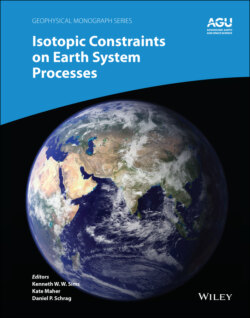Читать книгу Isotopic Constraints on Earth System Processes - Группа авторов - Страница 13
PART I: HIGH‐TEMPERATURE/DEEP EARTH PROCESSES
ОглавлениеA collaboration between Frank Richter – an author in this compilation – and Don DePaolo documented in a 2003 paper that diffusion in a silicate melt can produce measurable isotopic fractionations (Richter et al., 2003). This paper opened the door for a large number of subsequent studies and applications of kinetic isotope fractionation in silicate systems, both by mass transport in a melt or mineral (i.e. diffusion) or between phases (i.e. evaporation). In Chapter One, Frank Richter presents an overview of many of these papers.
In Chapter Two, Watkins et al. report previously unpublished results from Watkins’ PhD thesis with Don DePaolo and Rick Ryerson. In the years between 2005–2014, Watkins et al. published several papers on diffusive isotope effects in silicate melts of natural and simplified synthetic compositions. Their efforts advanced the theory of isotope diffusion and provided a general framework for predicting and interpreting stable isotope variability in igneous and metamorphic rocks. The results and novel analysis presented in this chapter expand the range of elements and compositions analyzed and offer new ideas for where to expect large diffusive isotope effects in nature.
For more than two decades, Don and a team of students, post‐docs, and collaborators have led the use of calcium isotope measurements for studying a diverse range of scientific problems, from biological to the earliest formed solids in our solar system. As a pioneer in the use of middle‐mass stable isotope systems, Don helped establish modern theoretical fractionation models for chemical reaction and diffusive transport, robust analytical techniques, and the isotopic compositions of common geological and planetary materials (Simon & DePaolo, 2010). Chapter Three reports Ca isotope measurements of several important mantle‐derived magmas to explore trace element and radiogenic isotope evidence for the presence of recycled sedimentary materials. Importantly, these data show no Ca isotopic signature of subduction in lavas from the Central American volcanic arc or in fresh carbonatite lavas from Oldoinyo Lengai Volcano, Tanzania, thereby demonstrating that sediment subduction is not a simple bulk mixing process.
Early in his career, Don pioneered the use of Nd isotope systematics in the Earth sciences and, at his first academic position at UCLA, many of his graduate students applied Nd systematics to studies of the origin and evolution of continental lithosphere, particularly in North America. In Chapter Four, one of these former students, Lang Farmer, reviews the chemical and radiogenic isotopic data from volcanic rocks and their entrained mantle‐derived xenoliths in SW North America and discusses how these data have revised our understanding of the Cenozoic evolution of this region.
Perhaps Don’s most cited work is his paper introducing his assimilation‐fractional crystallization (AFC) model as a means to understand magma chamber processes (DePaolo, 1981). In Chapter Five, Hammersley et al. present a comprehensive study of a large caldera system in Ecuador. In this study, Hammersley et al. use a finite difference application of the DePaolo AFC model (initially described in Hammersley & DePaolo, 2006) to interpret the chemical and isotopic evolution of the system and incorporate physical considerations of the rate at which magma can be generated and supplied to the crust from the mantle (Jellinek & DePaolo, 2003).
Nearly 30 years ago, as a graduate student of Don DePaolo, John Lassiter helped log core from the pilot hole of the Hawaii Scientific Drilling Project, thus starting a long career studying ocean island basalt genesis. In 1998, Lassiter and Hauri published a paper examining correlations between Os and O isotopes in Hawaiian basalts (including samples from the Mauna Kea drillcore), and argued for the presence of recycled oceanic lithosphere in the Hawaiian plume to explain anomalously “light” oxygen isotope signatures. In Chapter Six, Lassiter et al. re‐examine the role of shallow assimilation in Hawaiian basalt evolution by studying the geochemical signatures of “cognate” xenoliths from Mauna Kea, demonstrating that the hypothesis they proposed in 1998 is likely incorrect. This is another example of how science progresses as new tools become available, new data come to light, and old ideas either stand or fall in the face of new challenges.
Don’s first foray into the application U‐ and Th‐decay series systematics was with PhD student Ken Sims (Sims et al., 1995, 1999), a coauthor on this paper. Since then, both have gone on to take advantage of this versatile isotopic tool, whose nuclides’ half‐lives and chemical behaviors are diverse and uniquely suited to the study of recent geologic processes. In Chapter Seven, Giammanco and Sims demonstrate the use of short‐lived 220Rn (t1/2 = 55.6 seconds) and 222Rn (t1/2 = 3.825 days), coupled with CO2 efflux measurements, to establish the depths and timescales of degassing and monitor changes in subsurface magmatic activity beneath Mt Etna. Information that is critical for eruption forecasting on active volcanos.
